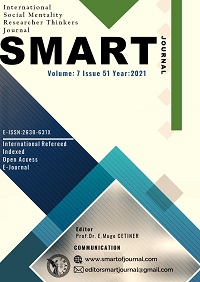DEDE KORKUT HİKÂYELERİNDEN “UŞUN KOCA OĞLU SEGREK DESTANI” HİKAYESİNİN GÖSTERGEBİLİM IŞIĞINDA İNCELENMESİ
Author :
Abstract
12 hikâyeden oluşan Dede Korkut Hikâyeleri, Türk kültürünün eşsiz şaheserleri olması ve Türk edebiyatında anlatıma dayalı eserler arasında önemli bir konuma sahip olması sebebiyle birçok incelemeye konu olmuştur. İster yazılı isterse sözlü olsun, edebî özellikler taşıyan Dede Korkut Hikâyelerinin çeşitli inceleme yöntemlerine göre araştırılması bu hikâyelerin ne kadar derin anlamlar taşıdığının bir göstergesidir. Biri Dresden’de, diğeri Vatikan’da olmak üzere iki nüshası olan bu Oğuz hikâyelerinden “Uşun Koca Oğlu Segrek Destanı” Saussure’ün ortaya atıp, Hjelmslev’in geliştirerek Greimas’ın kuramını oluşturduğu “Göstergebilim” yöntemine göre çözümlenmeye çalışılacaktır. Daha önce bu şekilde çalışılmamış olan bu hikâyede göstergebilimsel çözümlemenin yazınsal nitelikli bir metne nasıl uygulanabilir sorusu cevaplanarak Greimas’ın önerdiği eyleyenler modelinin uygulanması bu çalışmanın temel amacını oluşturacaktır.
Keywords
Abstract
Dede Korkut Stories, consisting of 12 stories, have been the subject of many studies because they are unique masterpieces of Turkish culture and have an important position among narrative works in Turkish literature. The investigation of Dede Korkut Stories, which have literary features, whether written or oral, according to various analysis methods is an indication of how deep these stories have. Among these Oghuz stories, one of which has two copies, one in Dresden and the other in the Vatican, the "Uşun Kocaoğlu Segrek Destanı" will be tried to be analyzed according to the "Semiology" method, which was put forward by Saussure and developed by Hjelmslev and formed the theory of Greimas. In this story, which has not been studied in this way before, the question of how semiotic analysis can be applied to a literary text will be answered and the application of the agent model proposed by Greimas will form the main purpose of this study.
Keywords
- Altunkaya, Hatice (2012). “‘Beyhude Ömrüm’ Adlı Hikâyenin Greımas’ın Eyleyenler Modeline Göre
- Altunkaya, Hatice (2012). “‘Beyhude Ömrüm’ Adlı Hikâyenin Greımas’ın Eyleyenler Modeline Göreİncelenmesi”, Turkısh Studıes - International Periodical For The Languages, Literature and History of Turkish or Turkic Volume 7/4, Fall 2012, p. 761-771, Ankara-Turkey.
- Anonim (2007). Dede Korkut’tan Çocuklara Seçme Hikâyeler, Ankara: Elips Kitap.
- Barthes, R. (Çev.) Rifat M – Rifat S. (2009). Göstergebilimsel Serüven, İstanbul, YKY.
- Caferoğlu, A. (1972). “Türklerde Av Kültü ve Müessesesi”, VII. Türk Tarih Kongresi Tebliğleri, c. 1. Eziler, Kıran, A. ve KIRAN Z. (2000). Yazınsal Okuma Süreçleri, Ankara: Seçkin Yayınevi.
- Greimas, A.J. (1983) Du Sens II, Paris: Seuil.
- Gürçay, S. (2016). “Duha Koca Oğlu Deli Dumrul” Hikâyesinin Göstergebilimsel Açıdan İncelenmesi Kahraman-Yücel Dağlı, İstanbul: Yapı Kredi Yayınları. Aydın Türklük Bilgisi, 2(3), 23-48.
- Kıran, A. (Ed.). (2003). Günümüz dilbilim çalışmaları. Multilingual.
- Kıran, Z. ve Kıran, A., (2006). Dilbilime Giriş (3. baskı), Ankara: Seçkin Yayınları. Kıran, A. ve Kıran, Z.(2007). Yazınsal Okuma Süreçleri, 3.
- Kuzu, T. S. (2004). Greımas’ ın Eyleyenler Modeli’nin, Bir Durum-Kesit Öyküsündeki İşlerliğine İlişkin Göstergebilimsel Çözümleme Denemesi. Dil Dergisi, (124), 34-52.
- Özbay M. ve Karakuş Tayşi E. (2011). Dede Korkut Hikâyelerinin Türkçe Öğretimi ve değer aktarımı açısından önemi. Pegem Eğitim ve Öğretim Dergisi,1(1),21-31.
- Özdarıcı, Ö. (2011). “Anlatı Tekniği Açısından Duha Koca oğlu Deli Dumrul Destanını Bir Çözümleme Denemesi”, Uluslararası Sosyal Araştırmalar Dergisi, c. 4, s. 16.
- Öztokat, N. (2004). “Göstergebilimsel Bir Okuma: Germınal”,Hasan Ali Yücel Eğitim Fakültesi Dergisi, c. 2, s. 151-168.
- Rifat, M. (2009). Göstergebilimin ABC’si, İstanbul: Simavi Yayınları.Üstünova, K. (2008). “Dede Korkut Kitabını Oluşturan Destanlardaki Ortak Özellikler”, TurkishStudiesInternational Periodical Fort The Languages, Literature and History of Turkish or turkic, 3(1), ss: 138- 144.
- Yücel, Tahsin (1979). Anlatı Yerlemleri. İstanbul: Oda Yayınları.
